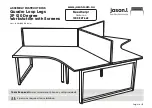
Theory of Operation
The following is a description of the operation of the test set. Reference the test set
block diagrams shown in
“System Block Diagram” on page
. This section
assumes the user has a general understanding of couplers, switches, and network
analyzers.
RF Coupler/Bridges
The test set uses 12 coupler/bridges (5087-7716 or 5087-7752) on the front panel for
RF Test Ports 5 - 16. The coupler/bridges provide the signal separation of the source
and receiver paths, using resistor networks. The test set ports can receive from or
stimulate a signal to the DUT.
The RF Test Port connectors are male 3.5 mm. The coupling factor is approximately
-16 dB for the Coupled Arm (minimum -22 dB and max -12 dB at 26.5 GHz). The
insertion loss through the CPLR THRU path is typically < 4 dB at 26.5 GHz. Do not use
excessive RF power or DC voltage, or damage may occur to the internal resistors.
Test Set Control Board
The Test Set Control Board (N5261-63006) is a surface mount, printed circuit
assembly (PCA). It provides a connection to the power supply, and the PNA Test Set
I/O for control of the RF switch paths (through the Switch Interface board
(Z5623-63647 or Z5623-63998). The front panel “Active” and port LEDs are on only
when the PNA has addressed the U3042AE12 Test Set. The rear panel fan is on when
the controller board supplies are operational.
RF Switch Components
The test set uses 12 solid-state switches (5087-7306 or 5087-7751) that have
internal 50 Ohm termination for each path. The switches select the RF paths from the
PNA source and receiver through interconnect cables to the test set. Network
analyzer Ports 1 thru 4 and test set Ports 5 thru 16.
Figure
61
Switch
3
1
2
C
4
U3042AE12 User's and Service Guide
75
















































